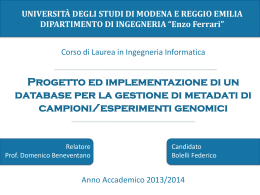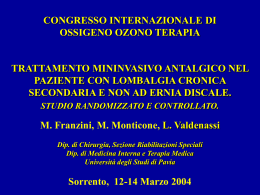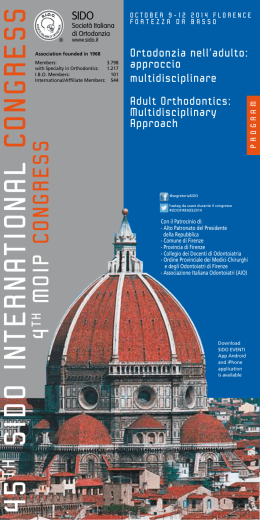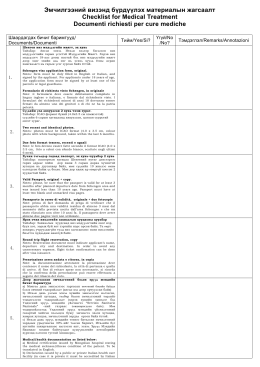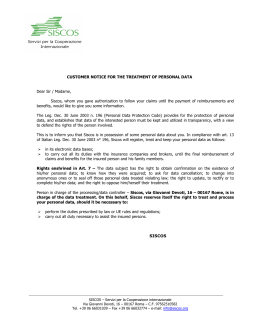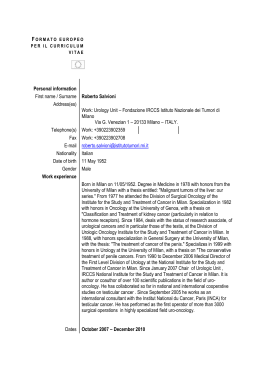1 Treatment in the Deciduous Dentition: Four Clinical Cases Treatment in the Deciduous Dentition: Four Clinical Cases Juan M. Font Jaume Private Practice, Palma de Mallorca, Spain Correspondence to: Juan Miguel Font Jaume Ramón Berenguer III, 1-Entlo 07003 Palma de Mallorca Tel.: +34 971 29.89.58 Fax: +34 971 20.40.78 E-mail: [email protected] Four clinical cases are presented in which treatment was initiated early, in the deciduous dentition. The cases were followed until the permanent dentition. When is the most appropriate time to treat in orthodontics? The issue of early treatment has always been and probably always be controversial. Turpin1,2 has written two editorials pointing out the doubts concerning this topic: This past summer I participated in the annual meeting of the CDABO, (College of Diplomats of the American Board of Orthodontics) where I asked the audience who would correct a severe posterior x-bite with a functional shift in a 6-year- 202 Early treatment of certain malocclusions is of great importance in orthodontics when normal growth and development is the objective of our therapy. The four cases presented illustrate the three types of malocclusion which must be treated early: cross-bites (transverse), Class III malocclusions (saggital) and open-bites (vertical). In most of these cases there is a deficiency of the maxilla. The maxilla is the template for the mandible in the early stages of development, and for this reason it should be treated early. As Ricketts said concerning early treatment: The crux of the dilemma is the failure to recognize complete maxillary orthopedics in the three planes of space. Font Jaume JM. Treatment in the Deciduous Dentition: Four Clinical Cases. Prog Orthod 2006;7(2):202-219. PROGRESS in ORTHODONTICS 2006; 7(2):202-219 Treatment in the Deciduous Dentition: Four Clinical Cases 2 old in the full deciduous dentition stage of development. I was surprised to see only a few hands go up, with most choosing to wait at least until the mixed dentition stage with all permanent incisors fully erupted. In the past quarter century, over 5˙000 articles and abstracts about maxillary expansion have been published. Unfortunately, despite the thousands of articles on posterior crossbites, there appears to be no clear consensus on the most efficient, effective, and stable method to correct them. The American Association of Orthodontists, through the patient education brochures, recommends the first orthodontic check up no later than Age 7, which obviously does not reinforce treatment in the deciduous dentition. In contrast, Pla- nas3 considers that the ideal therapy is from 3 to 6 years of age, and Ricketts4 suggested that in the future of orthodontics the only solution… is to treat very early. The best treatment in orthodontics will not be the one which uses the most appliances, but the one which gains perfection and stability of results with the fewest appliances. When we consider early treatment of the transverse dimension, it is of major importance to analyze the case thoroughly. It is a priority to analyze if there is any skeletal or dental asymmetry. When a skeletal or dental asymmetry is present, treatment should be started as soon as possible. Posterior lingual crossbite is the most common asymmetrical malocclusion. According to Thilander et al.5 the Quando l’obiettivo della nostra terapia è la corretta crescita ed il corretto sviluppo il trattamento precoce di alcune malocclusioni è di grande importanza in ortodonzia. I quattro casi presentati illustrano tre tipi di malocclusione che devono essere trattati precocemente: cross-bite (trasversale), malocclusione di Classe III (sagittale) e open-bite (verticale). Nella maggior parte dei casi è presente un deficit del mascellare. Nella prima fase dello sviluppo il mascellare funge da guida per la mandibola e per questa ragione deve essere precocemente trattato. A proposito del trattamento precoce Ricketts diceva: il nodo del problema è non riconoscere le potenzialità del trattamento ortopedico del mascellare nei tre piani dello spazio. Tradotto da Paola M. Poggio Key words: Deciduous dentition; Early treatment; Simplification of treatment, stability. PROGRESS in ORTHODONTICS 2006; 7(2):202-219 prevalence in the mixed and permanent dentition has been found to be of the same magnitude as in the deciduous dentition, the great majority of cases being unilateral, and very often associated with forced guidance (a shift). The uniform prevalence of cross-bites in different stages of dentition indicates that crossbites in the deciduous dentition are seldom self-correcting. It seems that the tendency to develop crossbites is increasing with evolution. Lindsten et al.6 compared a skeletal sample in the mixed dentition from the 14th to the 19th century and a sample of children of today. They found that the intermolar distance was greater in the 14th-19th century skeletal sample, indicating that the risk of developing a posterior crossbite was greater in today’s sample. As Gugino7 emphasizes, the earlier treatment begins, the more the face will adapt to your concept; the later treatment begins, the more your concept will have to adapt to the face. Therefore, there is a great advantage in treating crossbites early in order to avoid compensations and adaptations of the masticatory system to the asymmetric dentition, since this would lead to adaptive remodelling of the temporomandibular joints and asymmetric mandibular growth8. Slavicek9 also proposed very early treatment as a patient with a unilateral crossbite in the primary dentition develops a unilateral chewing pattern. A unilateral chewing pattern uses a unilateral neuromuscular system. The patient adapts to this asymmetric system… If you wait until the system develops fully – be- 203 3 Treatment in the Deciduous Dentition: Four Clinical Cases yond the 10th year of age – and now you create a symmetrical occlusion, you are inviting a relapse or a dysfunction case later on by introducing a symmetrical occlusion into an asymmetrical system. Malocclusions should be diagnosed in the three planes of space. Lateral cephalograms, photographs and study casts are not enough for a thorough diagnosis. Evaluation of the transverse dimension requires the analysis of the anteroposterior radiograph10. Even when there is no asymmetry or deviation there might be a skeletal discrepancy between the maxillary and mandibular width that requires treatment. Another type of malocclusion that requires consideration for early treatment is a Class III malocclusion. In Class III cases the decision on whether to start early or late is a real challenge. Patients that receive early orthopedic treatment to correct the skeletal disharmony might have to be retreated later due to differential skeletal growth of the maxilla and the mandible during the pubertal growth spurt. It is difficult to predict growth in young Class III patients. Following the Ricketts11 studies about growth forecast, there are several factors we look for in the prognosis of Class III cases. These are • a long body of the mandible from Xi to PM; • a forward position of the Xi point; • a short distance from the pterygoid vertical to porion; • a short anterior cranial base; • an obtuse gonial angle; 204 • a short ramus height and • an obtuse cranial deflection. The severity of these factors will be of value in the prognosis of Class III. Tollaro et al.12, studying Class III malocclusions in the deciduous dentition, found that most of the dimensional craniofacial characteristics which will be typical of Class III adults are already apparent. According to the results, the size of the mandibular body and ramus were greater in Class III children, and the mandibular body was long in relation to the linear extent of the anterior cranial base, which was shorter than the norm. The main goal of treatment is morphologic normality. However, the role of function should be given as much consideration as possible due to the interaction between form and function. Orthodontic treatment may result in an occlusion that is a morphologic success, but at the same time a functional failure which will lead to relapse. For this reason the diagnosis and treatment of potential problems in mastication, breathing, swallowing, posture and other oral habits that may lead to dysfunction, should be faced early. The influence of mastication on the craniofacial morphology and development is one of the reasons for early treatment. Each individual has a characteristic way of walking according to his sensorial mechanism, which although similar in every human being, acquires its own patterns, subject to specific genetic instructions and external influences. Likewise, each individual has a different chewing pattern caused by either genotypic or paratypic influences13. Early treatment should aim for a better development of the sensorial mechanism of each patient in order to achieve a proper chewing function, so that mastication itself will prevent the relapse of the cor- Le traitement precoce de certaines malocclusions est de grande importance en orthodontie quand la croissance et le développement normaux est l’objectif de notre thérapie. Les quatre cas présentés illustrent les trois types de malocclusion qui doivent être traités precocement: occlusions inveses (transversales), malocclusions de Classe III (saggital) et open bite (verticales). Dans la plupart de ces il y a une insuffisance du maxillaire supérieur. Le maxillaire supérieur est le calibre pour la mâchoire inférieure au commancement du développement, et pour cette raison il devrait être traité tôt. Comme Ricketts disait puor le traitement précoce: Le poit principal du dilemme est l’absence d’identifier l’orthopédie maxillaire complète dans les trois plans de l’espace. Traduit par Maria Giacinta Paolone PROGRESS in ORTHODONTICS 2006; 7(2):202-219 Treatment in the Deciduous Dentition: Four Clinical Cases 4 a c b Figs 1 Case 1. Pretreatment intraoral photographs. Fig. 2 Case 1. Pretreatment panoramic radiograph. Lines indicate asymmetry between right and left condyles. rected malocclusion. Another important aspect in treatment is the breathing pattern. The relationship between nasorespiratory function and dentofacial development remains controversial14. The prevailing opinion among orthodontists is that nasal airway impairment El tratamiento temprano de algunas maloclusiones es de gran importancia en ortodoncia cuando el crecimiento y desarrollo normal es el objetivo de nuestro tratamiento. Los cuatro casos que se presentan ilustran los tres tipos de maloclusiones que se deben tratar a una edad temprana: mordidas cruzadas (transversal), maloclusiones de Clase III (sagital) y mordidas abiertas (vertical). En la mayoría de estos casos existe una hipoplasia maxilar. El maxilar es la plantilla para la mandíbula en las etapas iniciales del desarrollo, y por ello se debería tratar pronto. Como dijo Ricketts en relación al tratamiento temprano: La clave del dilema esta en no reconocer que es necesario realizar ortopedia maxilar en los tres planos del espacio. Traducido por Blanca Font PROGRESS in ORTHODONTICS 2006; 7(2):202-219 and mouthbreathing may lead to microrhinodysplasia, adenoid facies, long face syndrome or open-bite malocclusion. While many reports support this premise, almost as many deny it. The clinical fact is that mouthbreating has an influence on muscles, decreasing the masseter muscle activities by about one third after nasal obstruction15, producing a low tongue position with unopposed lateral forces by the cheek musculature, or maintaining the lips apart, which decreases the pressure of the lips. All these factors may cause: maxillary arch constriction, extrusion of the molars, backward and downward rotation of the mandible and malposition of the incisors. As a consequence, the earlier we induce nose breathing the better growth and development will be. 205 5 Treatment in the Deciduous Dentition: Four Clinical Cases a Fig. 3 Case 1. Intraoral photograph with quadhelix appliance. a b Figs 4 Case 1. Comparison of intermolar width before treatment and after expansion with quadhelix. b Figs 5 Case 1. Pretreatment and postreatment extraoral photographs. a b c d e f Figs 6 Case 1. Posttreatment intraoral photographs. On the top, photographs taken at the end of treatment. On the bottom, photographs taken 11 years after the end of treatment. 206 PROGRESS in ORTHODONTICS 2006; 7(2):202-219 Treatment in the Deciduous Dentition: Four Clinical Cases 6 Clinical cases Case 1: B.B. 2 years 11 months (Figs 1-6). The concern of the patient’s parents was centered on the deviation of the face to the right side, as well as a difficulty in chewing. The patient’s attitude was very mature for her age. The patient had a unilateral crossbite with a forced guided occlusion (functional shift) that resulted from a transverse maxillary skeletal/dental deficiency. The mandible adapted to this deficiency for chewing convenience, working like a unilateral activator appliance. This child had a history of a pro- a longed dummy-sucking habit. The lowered tongue position and the extreme forces created by the buccinator muscles may have produced a narrow maxilla. The only approach to the treatment of this malocclusion was to expand the upper arch due to the transverse discrepancy between both arches. Before function is restored, form should be changed. Three different appliances were considered: RME (Rapid maxillary expansion), removable expansion plate, and a soldered quad-helix (Lingual arch wire expansion). The quad-helix appliance was selected due to a possible lack of cooperation. Although most of the expansion obtained with a quadhelix is orthodontic, orthopedic ex- b pansion is possible, particularly in younger age groups, in whom the palatal suture is active. Treatment was started with a quadhelix which was used for 3 months. The appliance was activated approximately 8 mm, or the buco-lingual width of an average deciduous second molar, with approximately 400 gr of force. This is generally sufficient activation to produce the desired maxillary expansion in the majority of cases, according to Chaconas16. In the permanent dentition, tooth position was corrected with fixed appliances for a period of 7 months in the upper arch and 10 months in the lower arch. The result was stable as shown at age 20. c d e Figs 7 Case 2. Pretreatment intraoral photographs. PROGRESS in ORTHODONTICS 2006; 7(2):202-219 207 7 Treatment in the Deciduous Dentition: Four Clinical Cases Case 2: M.O. 4 years 2 months (Figs 7-11) This male patient had a unilateral crossbite which was the same malocclusion as his older brother who had been treated previously. The orthodontic records and the functional analysis indicated that the patient had similar maxillary and mandibular intermolar and intercanine transverse dimensions; however, centric occlusion was not coincident with centric relation. There was a shift from centric relation to centric occlusion, due to the canine interference producing the forced gui- ded occlusion. The objective of treatment was to correct the dental malocclusion in order to improve mastication, which is very important for good oral health and normal growth and development at this age. Composite build-ups were used on the molars on the crossbite side and selective grinding was done on the non-crossbite side. During skeletal development and tooth eruption, readjustment of the occlusion was done by selective grinding for occlusal balance and proper mastication. The patient is waiting for full dental development before any further treatment is considered. Fig. 8 Case 2. Extraoral photograph. Lines indicate facial assymetry. a b c d e f Figs 9 a-f Case 2. Intraoral photographs during treatment. Photographs taken just after composite build-ups on right deciduous molars (a-c); photographs taken just after selective grinding (d-f). 208 PROGRESS in ORTHODONTICS 2006; 7(2):202-219 Treatment in the Deciduous Dentition: Four Clinical Cases 8 a b c d e f Figs 10 a-f Case 2. Intraoral photographs. Follow-up a b c Figs 10 a-f Case 2. Intraoral photographs. Follow-up Case 3: S.G. 5 years 3 months (Figs 12-19) The main complaint of the patient’s parents was: the mandible is too far forward. Her aunt had orthognathic surgery treatment. The patient presented with a full PROGRESS in ORTHODONTICS 2006; 7(2):202-219 Class III canine and molar malocclusion, a negative overbite of 4 mm, bilateral cross-bite and symmetric arches. Cephalometric measurements were analyzed. The anterior cranial base and the mandibular ramus were practically normal, however, the mandibular body was long in relation to the anterior cranial base. The porion location was smaller than the norm by two standard deviations. The SNA was smaller than the norm by one standard deviation, as well as the facial convexity. Several treatment options were considered. One of the options was to 209 9 Treatment in the Deciduous Dentition: Four Clinical Cases wait until the permanent dentition and then decide if a camouflage treatment is possible or if orthognathic surgery is indicated. Another alternative was to start treatment immediately with an orthopedic protocol in order to take advantage of the early age of the patient. The latter course of treatment was followed. Treatment was started with a fixed expansion appliance covering the occlusal surfaces with acrylic and a facial mask. Five months later the expansion and facial mask were removed and a removable appliance with a triple screw was pla- ced. A passive chin-cup made of canvas was used at night to enhance nose breathing. The upper appliance was removed 5 months later and a lower plate with a tongue-crib was used at night, together with the chin-cup to favor a normal tongue position. Seven years later, a b c d e f Figs 12 Case 3. Pretreatment intraoral photographs. a b Figs 13 Case 3. Pretreatment lateral radiograph and cephalometric traicing. 210 PROGRESS in ORTHODONTICS 2006; 7(2):202-219 Treatment in the Deciduous Dentition: Four Clinical Cases 10 when all the permanent dentition had erupted, fixed appliances were placed on the posterior mandibular teeth (from canines to second molars) for 7 months to detail tooth position. No other fixed appliances were used at the age of 18 years the case is stable. a b Figs 14 Case 3. Intraoral photographs with rapid maxillary expansion with hooks for facial mask. a b c d e f Figs 15 Case 3. Intraoral photographs. Follow-up. Figs 16 Case 3. Intraoral photographs. Follow-up. a b c d e f PROGRESS in ORTHODONTICS 2006; 7(2):202-219 211 11 Treatment in the Deciduous Dentition: Four Clinical Cases a b Fig 17. Case 3. Pretreatment and posttreatment lateral radiographs. a b Figs 18. Case 3. Pretreatment and posttreatment extraoral photographs. a b 212 PROGRESS in ORTHODONTICS 2006; 7(2):202-219 Treatment in the Deciduous Dentition: Four Clinical Cases 12 b a Figs 19. Case 3. Pretreatment and posttreatment lateral cephalometric traicings. Case 4: X.G. 6 years 8 months (Figs 20-28) The concern of the patient´s parents was centered on the mandible which they thought was too far forward, and her speech therapist recommended the visit to an ortho- dontist. The patient presented with an anterior open bite, bilateral crossbite, low tongue posture with hypertrophic tonsils. The patient had had a thumb-sucking habit. Cephalometric measurements were analyzed and revealed a very narrow maxillary width (J-J) with a value of 54.2 mm (three standard devia- a b d e PROGRESS in ORTHODONTICS 2006; 7(2):202-219 tions off the norm). The ramus height was short by two standard deviations. The ramus Xi position was too forward (two standard deviations off the norm), the gonial angle was very obtuse, and the porion location very short. Treatment was started with a RME (rapid maxillary expansion) and a facial mask with vertical pull c Figs 20 Case 4. Pretreatment intraoral photographs. 213 13 Treatment in the Deciduous Dentition: Four Clinical Cases a b c d Figs 21 Case 4. Intraoral photographs with rapid maxillary expansion with hooks for facial mask. e Figs 22 Case 4. Intraoral photographs. Follow-up before biofeedback therapy. Figs 23 Case 4. Intraoral photograph with quadhelix appliance. a b a b c d e f Figs 24 Case 4. Intraoral photographs. Follow-up after biofeedback therapy. 214 PROGRESS in ORTHODONTICS 2006; 7(2):202-219 Treatment in the Deciduous Dentition: Four Clinical Cases 14 a b a b a b Figs 25 Case 4. Pretreatment and posttreatment lateral radiographs. Figs 26 Case 4. Pretreatment and posttreatment extraoral photographs. PROGRESS in ORTHODONTICS 2006; 7(2):202-219 215 15 Treatment in the Deciduous Dentition: Four Clinical Cases a b Figs 27 Case 4. Pretreatment and posttreatment lateral cephalometric traicings. a b Figs 28 Case 4. Pretreatment and posttreatment anteroposterior traicings. for 8 months. A quad-helix was then placed and a passive chin-cup made of canvas was used at night to prevent mouth breathing. The patient had an adenoidectomy and tonsilectomy. Since the patient was chewing on the left side, composite build-ups were done on the upper deciduous left molars to favor chewing on the right side. Biofeedback therapy according to Gugino and Dus17 was used to reinforce proper functions. Upper and lower plates with Planas Tracks were used as retention. No fixed appliances were used during treatment. 216 References 1. Turpin DL. Good time for discussion of early treatment. Am J Orthod Dentofacial Or thop 2000 Sep; 118(3):247. 2. Turpin DL. Dealing with posterior crossbite in young patients. Am J Orthod Dentofacial Orthop 2004 Nov; 126(5):531-2. 3. Planas P. Le facteur áge dans la therapeutique orthodontique. LÕOrthodontie Française 1949;20:45-53. 4. Ricketts RM. FOR Newsletter volume XXXI nº3 winter 2000. 5. Thilander B, Wahlund S, Lennartsson B. Eur J Orthod 1984; 6:25-34 The effect of early interceptive treatment in children with posterior cross-bite. Eur J Orthod. 1984 Feb;6(1):25-34 6. Lindsten R, Ogaard B, Larsson E, Bjerklin K. Transverse dental and dental arch depth dimensions in the mixed dentition in a skeletal sample from the 14th to the 19th Century and Norwegian children and Norwegian Sami children of today. Angle Orthod 2002 Oct; 72(5):439-48. 7. Gugino C. Proceeding Foundation for Orthodontic Research 1995. 8. Santos-Pinto A, Buschang PH, Throckmorton GS, Chen P. Morphologic and positional asymmetries of young children with functional unilateral cross bite. Am J Orthod Dentafac Orthop 2001;120:513-520 (reference added by the Editor and renumbered according to the sequence of citation). PROGRESS in ORTHODONTICS 2006; 7(2):202-219 Treatment in the Deciduous Dentition: Four Clinical Cases 16 9. Slavicek R. Dr. Rudolf Slavicek on clinical and instrumental functional analysis for diagnosis and treatment planning. Part 1. Interview by Dr. Eugene L. Gottlieb. J Clin Orthod 1988 Jun;22(6):358-70. 10. Vanarsdall RL. Transverse dimension and long-term stability. Semin Orthod 1999 Sep;5(3):171-80. 11. Ricketts RM. Robert M. Ricketts on early treatment (Part 3). J Clin Orthod 1979 Mar;13(3):181-99. 12. Tollaro I, et al. Class III malocclusion in the deciduous dentition: a morphological and correlation s t u d y. E u r J O r t h o d 1 9 9 4 Oct;16(5):401-8. 13. Simöes WA. Mastication. J Japan Orthod Soc 1979;38(3):322-332. [Mastication (author’s transl)] Ortodontia. 1979 Jan-Apr;12(1):1928. Review. Portuguese. No abstract available. 14. Warren DW, Spalding PM. Dentofacial morphology and breathing: A century of controversy. In: Melsen B. Current Controversies in Orthodontics. Quintessence Publishing Co.Inc;1991. 15. Yamada K. The relationship between chewing function and malocclusion. J Japan Or thod Soc 1992;51:104-111. 16. Chaconas SJ, de Alba, Levy JA. Orthopedic and orthodontic applications of the quad-helix appliance. Am J Orthod 1977;72(4):422-8. 17. Gugino C, Dus I. Zerobase bioprogressive unlocking concepts: the interplay between form and function. Rev Ortho Dento Faciale 2000;34:83-107. Trattamento in dentizione decidua: quattro casi clinici Juan M. Font Jaume Vengono presentati quattro casi in dentizione decidua nei quali è stato eseguito un trattamento precoce. I casi sono stati seguiti fino alla dentizione permanente. Qual è il momento migliore per iniziare il trattamento ortodontico? Le indicazioni al trattamento precoce sono da sempre e probabilmente saranno sempre oggetto di discussione. Turpin1,2 ha scritto due editoriali sull’argomento sottolineando alcuni punti dubbi: La passata estate ho partecipato al meeting annuale della CDABO (College of Diplomats of the American Board of Orthodontics) in questa occasione ho chiesto ai presenti chi tra loro avrebbe curato un bambino di 6 anni con dentatura decidua completa ed un severo morso incrociato posteriore con shift laterale. Mi sono stupito di vedere solo poche mani alzarsi, la maggioranza dei presenti preferiva aspettare almeno fino ad essere in dentatura mista con tutti gli incisivi permanenti erotti. Nei passati 25 anni sono stati pubblicati più di 5000 articoli e abstract sull’espansione del palato. Sfortunatamente nonostante centinaia di articoli sui cross-bite posteriori, non esiste ancora un pieno consenso sul metodo più efficiente, efficace e stabile per correggerli. L’American Association of Orthodontists per mezzo di brochures consiglia un primo controllo ortodontico non più tardi dei 7 anni, e ciò non favorisce ovviamente i trattamenti in dentatura decidua. Al contrario Planas3 considera terapia ideale quella tra i 3 ed i 6 anni e per Ricketts4 il trattamento molto precoce sarà l’unica soluzione nel futuro dell’ortodonzia. Il miglior trattamento in ortodonzia non è quello che impiega più apparecchiature ma quello che raggiunge la perfezione e la stabilità dei risultati con il minor numero di apparecchi. Ogniqualvolta valutiamo un trattamento precoce per pro- PROGRESS in ORTHODONTICS 2006; 7(2):202-219 blematiche trasversali, è importante analizzare il caso in modo completo. È assolutamente prioritario analizzare se ci sono asimmetrie di tipo scheletrico o dentale. In presenza di una asimmetria trasversale il trattamento va iniziato il più presto possibile. Il cross-bite posteriore è l’asimmetria più frequentemente riscontrabile. Secondo Thilander e Coll.5 la frequenza di cross-bite in dentatura mista è la stessa riscontrata in dentatura permanente, nella maggior parte dei casi è unilaterale e spesso è associata ad uno scivolamento. L’uniformità d’incidenza dei casi con cross-bite in fasi differenti della dentatura indica che i cross-bite in dentatura decidua raramente si correggono da soli. La tendenza a sviluppare cross-bite sembra essere associata all’evoluzione. Lindsten e Coll.6 hanno comparato tra loro alcuni scheletri di bambini in dentatura decidua del XIV secolo, del XIX secolo e contemporanei. Hanno trovato una distanza intermolare maggiore negli scheletri del XIV e del XIX secolo rispetto a quelli di oggi, ciò indica che il rischio di sviluppare un cross-bite posteriore è maggiore oggi rispetto ad un tempo. Come enfatizzato da Gugino7 più precoce il trattamento inizia maggiormente il viso del paziente si adatterà al nostro ideale; più tardi il trattamento inizia e maggiormente il nostro ideale si dovrà adattare al viso del paziente. Trattare i cross-bite precocemente ci offre il grosso vantaggio di evitare che si creino compensi e compromessi nel sistema masticatorio, il quale si adatta all’asimmetria della dentatura; sono questi compensi che portano a un processo di rimodellamento delle articolazioni temporomandibolari ed a una crescita asimmetrica della mandibola8. Slavicek9 propone il trattamento precoce dei cross-bite per prevenire il formarsi di un pattern di masticazione unilaterale. Un 217 17 Treatment in the Deciduous Dentition: Four Clinical Cases pattern di masticazione unilaterale comporta l’uso unilaterale del sistema neuromuscolare. Il paziente si adatta ad un sistema asimmetrico se aspettiamo che il sistema si sviluppi completamente – oltre i 10 anni – e poi ricreiamo un’occlusione simmetrica in un sistema asimmetrico il caso sarà a rischio di recidiva o di disfunzione. Le malocclusioni vanno sempre diagnosticate nei tre piani dello spazio. Le radiografie laterali, le fotografie e lo studio dei modelli non sono sufficienti per una diagnosi approfondita. Per valutare il diametri traversi è necessario eseguire una radiografia postero-anteriore10. Anche se non c’è asimmetria o deviazione può esserci una discrepanza scheletrica tra l’ampiezza del mascellare e della mandibola tale da richiede un trattamento. Un altro tipo di malocclusione che richiede un intervento precoce è rappresentato dalle III Classi. In questi casi decidere se iniziare il trattamento precocemente o se ritardarlo è una vera sfida. Se i pazienti vengono trattati precocemente per correggere la disarmonia scheletrica spesso rischiano di dover essere ritrattati più tardi a causa del differenziale di crescita scheletrica tra il mascellare e la mandibola che si verifica durante il durante il picco puberale. In base agli studi di Ricketts11 sulla previsione di crescita ci sono alcuni fattori ai quali dobbiamo guardare per fare una prognosi delle III Classi. Questi fattori sono: • un corpo mandibolare lungo da Xi a PM; • un’avanzamento del punto Xi; • una riduzione della distanza tra la verticale pterigoidea e porion; • una base cranica anteriore ridotta; • un angolo goniaco ottuso; • un ramo mandibolare corto; • un’angolo craniale ottuso. La gravità di tutti questi fattori è d’aiuto per la prognosi delle III Classi. Tollaro e Coll.12, studiando le III Classi hanno visto come tutte le caratteristiche dimensionali craniofacciali tipiche delle III Classi negli adulti siano già presenti nei in dentizione decidua. Secondo i loro risultati, la lunghezza del corpo e del ramo della mandibola erano maggiori nei bambini in III Classe, e il corpo mandibolare era lungo rispetto alla lunghezza della base cranica anteriore che era più corta della norma. L’obbiettivo del trattamento è quello di raggiungere la normalità morfologica. Tuttavia alla funzione dovrebbe essere dato il massimo risalto possibile e ciò per la stretta correlazione tra la funzione e la forma. Un trattamento ortodontico può ottenere come risultato una perfetta occlusione ossia un successo morfologico, ma allo stesso tempo può essere un fallimento funzionale che porterà a una recidiva. Per questo la diagnosi ed il trattamento di potenziali problemi masticatori, respiratori, di deglutizione, di postura, o altre abitudini orali che possono portare a disfunzione deve essere fatta precocemente. L’influenza della masticazione sulla morfologia cranio facciale e sullo sviluppo è una delle indicazioni al trattamento precoce. Ciascun individuo ha il proprio caratteristico modo di camminare 218 che dipende da specifici meccanismi sensoriali, che sono simili in ciascun essere umano ma che acquistano il loro specifico pattern, in base alle indicazioni genetiche ed alle influenze esterne. Allo stesso modo ciascun individuo ha un suo differente pattern masticatorio determinato dalle influenze sia genetiche che ambientali13. Il trattamento precoce deve mirare ad un corretto sviluppo dei meccanismi sensoriali del paziente permettendogli di raggiungere così una corretta funzione masticatoria, in grado a sua volta di prevenire eventuali recidive della malocclusione corretta. Un altro importante aspetto del trattamento è rappresentato dalla respirazione. La relazione tra la funzione naso-respiratoria e lo sviluppo facciale resta controversa14. L’opinione prevalente tra gli ortodontisti è che un impedimento delle vie aeree e la respirazione orale possono portare allo sviluppo di microrinodisplasia, facies adenoidea, alla sindrome della faccia lunga o ad open-bite. Esistono tanti lavori che provano questo e altrettanti che lo negano. La clinica ci dimostra che in presenza di un’ostruzione del naso la respirazione orale influenza i muscoli in quanto l’attività del massetere diminuisce all’incirca di un terzo15, si determina una postura bassa della lingua che bilancia più la forza delle guance e mantiene le labbra aperte determinando una diminuzione della pressione delle labbra. Tutto ciò contribuisce a creare una contrattura dell’arcata, l’estrusione dei molari con rotazione in basso ed in dietro della mandibola e malposizione degli incisivi. Di conseguenza prima noi ricreiamo una corretta respirazione nasale tanto migliore sarà la crescita. Casi clinici Caso 1: B.B. 2 anni 11 mesi (Figg. 1-6) I genitori della paziente erano preoccupati per la deviazione del viso della bambina verso destra e la sua difficoltà a masticare. La paziente era molto matura per la sua età. A causa di un deficit del diametro trasversale del mascellare presentava un cross-bite unilaterale con uno shift funzionale. La mandibola si era adattata a questa deficienza per ottenere una posizione di comodo che lavorava come un attivatore monolaterale. La bambina aveva succhiato il ciuccio a lungo. La postura bassa della lingua e le forze estreme create dai muscoli buccinatori potevano aver contribuito a creare un mascellare stretto. L’unico trattamento a questa malocclusione era quello di espandere l’arcata superiore per correggere la discrepanza tra i diametri delle due arcate. Perché si possa ricreare la corretta funzione si deve prima ricreare la forma. Tre differenti apparecchi sono stati valutati: RME (rapid maxillary expansion), una placca rimovibile di espansione, ed un qad-helix saldato (lingual arch wire expansion). Temendo una possibile mancanza di cooperazione fu scelto il quad-helix. Anche se l’espansione con il quad-helix è ortodontica, un’e- PROGRESS in ORTHODONTICS 2006; 7(2):202-219 Treatment in the Deciduous Dentition: Four Clinical Cases 18 spansione ortopedica è possibile sopratutto nei soggetti più giovani in cui la sutura palatina e attiva. Il trattamento con quad-helix fu di tre mesi. L’apparecchio fu attivato di circa 8 mm, o della larghezza bucco-linguale media di un secondo molare deciduo, con circa 400 gr di forza. Secondo Chaconas16 questa è una attivazione generalmente sufficiente nella maggior parte dei casi per ottenere l’espansione desiderata. Una volta in dentatura permanente, il caso fu terminato con un’apparecchiatura fissa per 7 mesi nell’arcata superiore e per 10 mesi nell’arcata inferiore. A 20 anni il risultato è ancora stabile. Caso 2: M.O. 4 anni 2 mesi (Figg. 7-11) Questo paziente presentava un cross-bite unilaterale uguale al fratello maggiore precedentemente trattato. La documentazione e l’analisi funzionale indicavano che i diametri trasversali intermolari ed intercanini del mascellare e della mandibola erano uguali tra loro; tuttavia l’occlusione centrica non coincideva con la relazione centrica. C’era uno scivolamento dalla seconda verso la prima dovuto all’interferenza di un canino che determinava un’occlusione forzata. L’obbiettivo del trattamento era quello di correggere la malocclusione per migliorare la masticazione, cosa molto importante per mantenere una buona salute dentale e per uno sviluppo eugnatico. Sui molari del lato del cross-bite furono posti dei rialzi in composito mentre sul lato senza crossbite fu fatto del molaggio selettivo. Durante lo sviluppo scheletrico e l’eruzione dei denti fu eseguito un ulteriore molaggio selettivo d’aggiustamento per creare un buon equilibrio masticatorio. Il paziente deve ora aspettare il completo sviluppo della dentatura prima di prendere in considerazione qualsiasi ulteriore trattamento. Caso 3: S.G. 5 anni 3 mesi (Figg. 12-19) La preoccupazione dei genitori di questo piccolo paziente era la crescita in avanti della mandibola. Una zia era stata sottoposta a chirurgia ortognatica. Il paziente aveva una piena III Classe sia canina che molare, un over-bite negativo di 4 mm, un cross-bite bilaterale, le arcate simmetriche. In base all’analisi cefalometrica la base cranica anteriore e il ramo mandibolare erano normali ma il corpo della mandibola era lungo in confronto alla base cranica anteriore. La distanza del porion a PTV era minore rispetto alla norma di due volte la deviazione standard. L’angolo SNA e la convessità facciale erano minori rispetto alla norma di una PROGRESS in ORTHODONTICS 2006; 7(2):202-219 volta la deviazione standard. Furono valutate più opzioni terapeutiche: la prima era quella di aspettare fino alla dentatura completa e quindi decidere o per un trattamento di camouflage, o per un trattamento chirurgico. L’alternativa era quella di iniziare il trattamento subito, con un protocollo ortopedico cercando di trarre beneficio dalla giovane età del paziente. Questa fu la soluzione scelta. Da prima fu utilizzato un espansore fisso con copertura delle superfici occlusali ed una maschera facciale. Dopo cinque mesi l’espansore e la maschera facciale furono rimossi e fu dato al paziente un apparecchio rimovibile con una tripla vite, di notte il paziente portava anche una mentoniera di tela, passiva che lo obbligava a respirare con il naso. Dopo cinque mesi fu sospeso l’apparecchio superiore e al fine di favorire una corretta posizione della lingua fu data al paziente una placca inferiore con una griglia per la lingua da indossare di notte insieme alla mentoniera. Sette anni dopo a permuta ultimata fu posizionata una apparecchiatura fissa solo inferiormente da canino a secondo molare per 7 mesi al fine di dettagliare la dentatura posteriore. Non furono usati altri apparecchi fissi. All’età di 18 anni il caso è stabile. Caso 4: X.G. 6 anni 8 mesi (Figg. 20-28) La preoccupazione dei genitori del paziente era la crescita secondo loro troppo in avanti della mandibola e il logopedista aveva consigliato una visita ortodontica. Il paziente presentava un open-bite anteriore, un cross-bite bilaterale, una postura bassa della lingua con ipertrofia delle tonsille. Il paziente aveva succhiato il pollice. Dall’analisi cefalometrica risultava che l’ampiezza mascellare (J-J) era molto ridotta con un valore di 54,2 mm (inferiore tre volte la deviazione standard della norma). L’altezza del ramo ridotta di due volte la deviazione standard della norma. Il punto Xi era più avanti (due volte la sd della norma), l’angolo goniaco era molto ottuso e la posizione del porion molto avanzata. Il trattamento è iniziato con un RME (rapid maxillary expansion) e una maschera facciale con una trazione alta per 8 mesi. Fu poi posizionato un quad-helix ed una mentoniera di tela, passiva da portare di notte per impedire la respirazione orale. Il paziente fu sottoposto ad adenoidectomia e tonsillectomia. Poichè il paziente masticava solo dal lato di sinistra furono fatti dei rialzi in composito sui molari decidui superiori di sinistra per favorire la masticazione sul lato i destra. Fu quindi eseguita una terapia di Biofeedback secondo Gugino e Dus17 per rinforzare le corrette funzioni. Come ritenzione furono usate le placche di Planas. Durante il trattamento non furono mai impiegate apparecchiature fisse. Tradotto da Paola M. Poggio 219
Scarica
